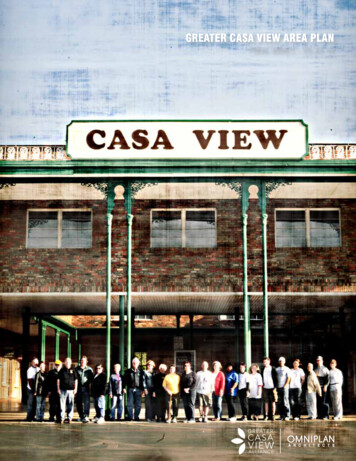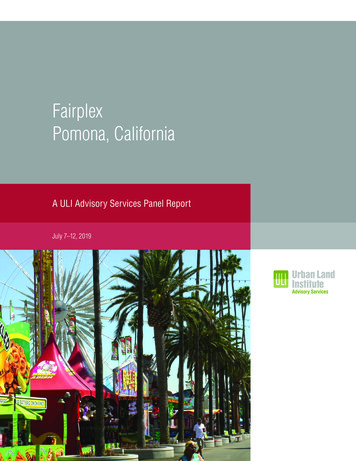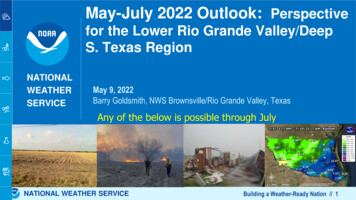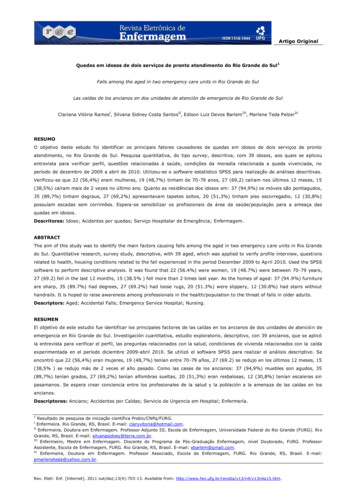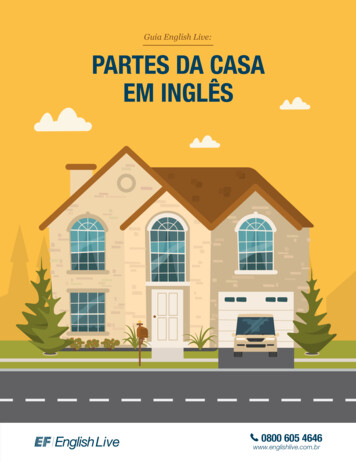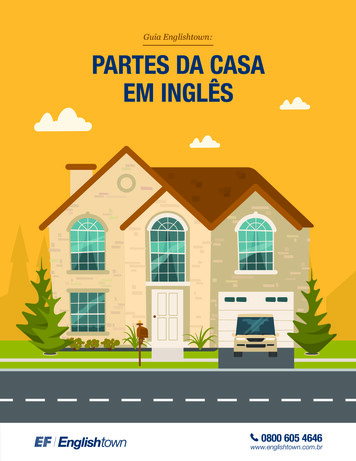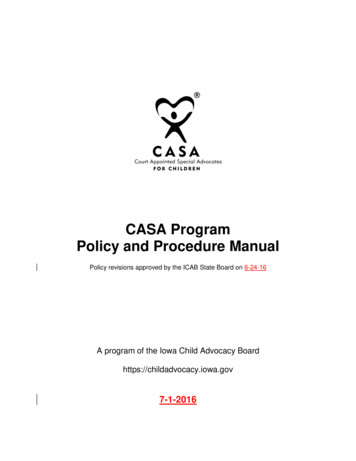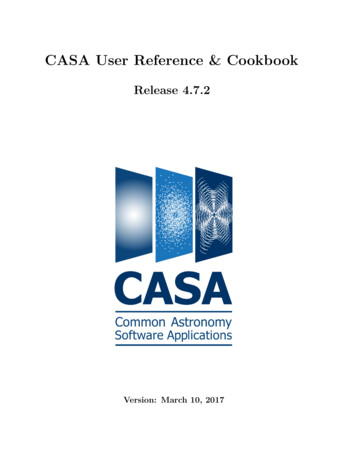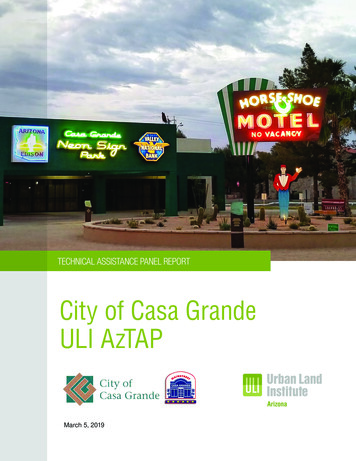
Transcription
TECHNICAL ASSISTANCE PANEL REPORTCity of Casa GrandeULI AzTAPMarch 5, 2019
AcknowledgmentsA robust team of people were instrumental in making this AzTAP a success.The Urban Land Institute Arizona District Council (ULI Arizona) gratefullyacknowledges the following individuals who serve Casa Grande for beingsuperb partners and for their enthusiasm and commitment. ULI Arizona isgrateful to the Casa Grande City Council and Main Street Organization for theirdedication of leadership and support.CITY OF CASA GRANDECITY COUNCILCraig McFarland, MayorDonna McBride, Mayor ProTemporeDick Powell, CouncilmemberMary Kortsen, CouncilmemberMatt Herman, CouncilmemberLisa Navarro Fitzgibbons,CITY OF CASA GRANDEMAIN STREETRichard Rosales, PresidentAffiliation: APSJim Sommers, Vice PresidentAffiliation: Sommers Auto GlassSusan Rooney, SecretaryAffiliation: Adventures in Stained GlassMary Ann Versluis, TreasurerCouncilmemberWendy LloydRobert Huddleston,DepartmentCouncilmemberCASA GRANDEMAIN STREET STAFFRina Rien, DirectorAffiliation: Casa Grande PoliceCouncilmember Dick Powell, City ofCasa Grande Council LiaisonAffiliation: Powell Feed & SupplyLaura Blakeman, City of Casa GrandeStaff LiaisonThomas Anderson, City of CasaGrande Police LiaisonKirk McCarville, Ex-Officio BoardMemberAffiliation: Land Advisors OrganizationTHANK YOU ULI AZTAP CASA GRANDE SUPPORTERSCover image: Neon Sign Park “Grande” opening April 13, 2019. www.neonsignpark.com
Table of ContentsULI AZTAP CASA GRANDE PROCESS 4ULI AZTAP CASA GRANDE PURPOSE AND FOCUS 6ABOUT DOWNTOWN CASA GRANDE 7BACKGROUND RESEARCH10PANEL DISCUSSION 14ENHANCING THE “PLACE” ZONING, CIRCULATION, ANDHISTORIC PRESERVATION 20(RE)DEVELOPMENT CONCEPTUALIZATION 23BUILDING MARKET POTENTIAL AND ECONOMIC CAPACITY24FINANCE & IMPLEMENTATION 27SUSTAINING MOMENTUM & LEADERSHIP30NEXT STEPS 31APPENDIX:STUDIES & REPORTS33STRATEGIC FOCUS AREAS, QUESTIONS37AGENDA 40ABOUT THE PANEL41
About ULIULI ARIZONA DISTRICT COUNCILThe Urban Land Institute is a 501(c)(3) non-The ULI Arizona District Council was formedprofit research and education organizationin the early 1980s, as a direct response tosupported by its members. Founded in 1936,the need for educational forums and eventsthe Institute has members in 95 countriesat a local level. ULI Arizona brings publicworldwide, representing the entire spectrumand private sector leaders together to shareof land use and real estate development dis-and exchange ideas, information, and expe-ciplines working in private enterprise andriences to shape the way communities grow.public service. The mission of the UrbanFor additional information, please visit: www.Land Institute is to provide leadership in thearizona.uli.org.responsible use of land and in creating andsustaining thriving communities worldwide.ABOUT ULI AZTAPSThe ULI Arizona Technical Assistance Panelholistic lens that they provide to help resolve(AzTAP) Program is a service offered bylocal issues.ULI Arizona to assist Arizona municipalities,counties, regions, and nonprofits in the preliminary study of complex land use planning,development, and redevelopment issues.ULI ARIZONA STAFFDebra Z. Sydenham, FAICPExecutive DirectorKristen Busby, AICPDirectormembership base, AzTAPs provide objective and responsible guidance on a varietyof land use and real estate strategic decisions ranging from site-specific projects topublic policy questions.direction from highly qualified industryprofessionals who volunteer their time.Professionals who bring their expertise tobear also receive an intimate understanding of the unique development opportunities and challenges facing communities.The interaction among panel experts, localcommunities, and residents strengthens thecommunity fabric and builds opportunitiesAzTAP was initiated by the ULI Arizonafor strong public and private sector collab-District Council in 2003 as an extensionoration to promote thriving Arizona com-of the time-tested national ULI Advisorymunities. The focus and scope of issuesServices Program that was established indefined by the local sponsoring community1947 with proven success for its compre-make each TAP unique, so the approachhensive, pragmatic approach to solvingis intentionally flexible to tailor it to the spe-land use challenges. Technical assistancecific needs presented. Past ULI Arizona TAPKristen Busby, AICPinterdisciplinary panel teams are carefullyreports are available to view and downloadULIchosen for their specific knowledge and theat www.arizona.uli.org.Gerri LippDirectorREPORT AUTHORSLeslie Dornfeld, FAICPPLAN-et Consulting2Drawing from a seasoned professionalCommunities gain valuable insight andT E C H N I C A L A S SI S TA N C E PA N E L R E P O R T
ULI AzTAP PanelPANELISTSJohn McNamara, FAICP, AIA Bob Graham, AIA NCARBPanel ModeratorVice President, AECOMJamie Blakeman, PETraffic Section LeadJ2 Engineering and DesignMartha dePlazaolaAbbott, LEED AP BD CCo-Managing DirectorGenslerAZTAP COMMITTEECameron CarterPartner, Rose Law GroupGeorge ColeDirector, Fennemore Craig, PCDoug CraigVice President,RVi Planning LandscapeArchitectureMark Davis, Vice ChairOwner, 48 DevelopmentCompanyLeslie DornfeldPrincipal, PLAN-etWilliam FrancisWilliam Francis, RLAConsultantAngie GrendahlRetail Development Manager,Thompson ThriftCJ HagerDirector, Community HealthPolicies, Vitalyst HealthFoundationLEED-APPrincipal ArchitectMotley DesignKimber LanningFounderLocal First AZJeffrey McVay, AICPManager of DowntownTransformationCity of Mesa, AZTom HesterAssociate Vice President,Urban Design Director, Gulf/Southwest Region, AECOMAmy Malloy, ChairManaging Principal, EvolveVenturesChelsea McCawPlanner, RVi Planning Landscape ArchitectureSpalding OlmstedPresident/CEO,The Spalding GroupDebbie ParkinsBusiness Development,Western Technologies, Inc.Kelly PattonSenior Economic DevelopmentConsultant, APSKate PerrinConsultant - BusinessDevelopment, Form ThirdMaxSommacampangaFounding DeveloperCIMA Holdings/ SommaRealty/ SommacampagnaHomesSylvia UrrutiaFounderU Developing, LLC/AZHousing AllianceCandace RasauroDirector, Jokake ConstructionLance Ross, EmeritusPresident, Ross PropertyAdvisorsJudie ScalisePrincipal, ESI CorporationKim ShapiroVice President, SkanskaMeagan SnyderDirector of BusinessDevelopment, EPS GroupJon VlamingCommunity DevelopmentDirector, City of EloyBrook VinkBusiness DevelopmentManager, Wood/PatelJacob Zonn, Vice ChairSenior Planner, Tiffany &Bosco, P.A.Michael PhalenPartner, Lewis RocaRothberger Christie LLCC A S A G R A N D E U L I A Z TA P3
ULI AzTAP Casa GrandeProcessThe Casa Grande AzTAP was initiated when Casa Grande Main Streetcontacted ULI Arizona for assistance on ways to leverage their new NeonSign Park as an attractor (and other strategies) to build the market potential ofdowntownAfter receiving the application, volunteer ULI AzTAP Committee members metwith local community leadership to understand and refine the assignmentobjectives and identify key issuesThe ULI AzTAP Committee worked closely over several months with leadersfrom the City and Casa Grande Main Street to carefully select the best paneland prepare the logistics for Panel Day?Key questions were thoughtfully developed and refined to guide the panel’sdiscussion of important real estate enquiries – the big picture vision, planningand design, market potential, redevelopment strategies, finance andimplementationEight panel experts were ultimately chosen for their specific knowledge andability to transfer their best practice solutions to help Casa Grande addresstheir important questionsA detailed briefing book was prepared by Casa Grande and transmitted toeach AzTAP panel member. This addressed community, demographics,economic and land use studies, and other information to support the panelists’preparation for Panel Day4T E C H N I C A L A S SI S TA N C E PA N E L R E P O R T
The ULI AzTAP Committee and the selected panelists also conductedinterviews with key stakeholder in the downtown Casa Grande study area.This insight was invaluable to know and helped panelists hit the groundrunning for Panel DayThe AzTAP kicked off with a guided walking tour of the study area the morningthe panel convened in Casa Grande – Panel DayThe panel worked diligently over the course of an entire day to brainstormstrategies to support the City’s efforts to revitalize the downtown Main Streetarea as an exciting hub of mixed use commerce and activityThis printed report summarizes the findings and practical recommendationsfor next steps. A presentation highlighting the outcomes of the panel is alsoprovided to the Casa Grande City Council for consideration and acceptanceULI AzTAP Casa GrandePanel Day.C A S A G R A N D E U L I A Z TA P5
ULI AzTAP Casa GrandePurpose and FocusFocusLeverage both city and privately-owned land to help catalyze the revitalizationof Downtown Casa Grande.PurposeCasa Grande’s Neon Sign Park will open April 2019 with 14 restored CasaGrande neon signs. This unique asset will attract visitors to the historic CasaGrande Downtown and is viewed as an opportunity for revitalization.This ULI Arizona Technical Assistance Panel focused on opportunities toleverage the Sign Park through redevelopment strategies for the downtownarea.Casa Grande Leadership and AzTAPPanel in front of the historic Casa GrandeParamount Theatre. From left to right:Casa Grande Mayor Craig McFarland;AzTAP Panelists - Kimber Lanning,Martha dePlazaola Abbott, SylviaUrrutia, Max Sommacampanga, JohnMcNamara, Jamie Blakeman, RobertGraham, Jeffrey McVay; and CasaGrande Main Street Director Rina Rien.6T E C H N I C A L A S SI S TA N C E PA N E L R E P O R T
About Downtown CasaGrandeCasa Grande’s historic downtown is unique within the Central Arizona region.This historic heart of the city was founded in 1879 when a work stoppageoccurred on rail deliveries from the East. Southern Pacific set up a temporarycamp called Terminus (end of the line). Construction resumed in January 1880and, by September 1880, the Southern Pacific Railroad had renamed the townCasa Grande after the nearby Casa Grande ruins.In 1890, the original townsite map was recorded and the historic downtownstarted to develop around Main Street. Parallel and perpendicular with therailroad tracks, downtown streets are organized northwest-southeast reflectingthe area’s origins as a railroad community. (The City’s streets are alignedDowntown Casa GrandeMain Street.north/south.) In 1886, 1893 and 1914 fires ravaged the town. In 1908 a flooddamaged the town, but each time the community survived and rebuilt.In 1928 - Highway 84 (the Old Tucson Highway) extended north from Tucson/Picacho through Casa Grande to Gila Bend. Motor courts and neon signscame thereafter. Today the historic downtown includes about 110 acres of turnof-the century and mid-century modern buildings.Conserving the downtown continues to be an ongoing focus of the City,downtown landowners, and merchants. Casa Grande Main Street is a nonprofit 501c3 organization working to promote and enhance downtownrevitalization and historic preservation.The Cook E Jar Bakery and Caféis a local gathering spot andknown throughout the region forits’ fresh baked goods.Casa Grande Main Street Organization's Mission:“To support the vision of Historic Downtown by enhancing the economicvitality, promoting and marketing the District, fostering partnershipsand acting as the lead advocate for Historic Downtown and its historicpreservation.” Main Street’s vision for the downtown is, “an exciting, visuallyappealing, easily accessible, safe, balanced mix of uses that integratesresidential, office, retail, entertainment, dining, and cultural and civicactivities that is recognized as the heart of the community.”C A S A G R A N D E U L I A Z TA P7
Substantial work to redevelop the downtown has occurred. The ParamountTheatre, constructed in 1929 and a “sister” theatre to the historic downtownPhoenix Orpheum Theatre, operates as a concert hall and event venue. TheMuseum of Casa Grande is located downtown and open Thursday throughSaturdays (and closed for the summer). The historic Women’s Club includesa BlackBox theatre and the Casa Grande Arts Museum. New and establishedrestaurants are located throughout the downtown and include the CGQBBQ, Big House Cafe, and the Cook E Jar Bakery & Cafe. The heart of thedowntown is along Florence Street. An active City of Casa Grande IndustrialMurals telling CasaGrande’s history adornthe downtown.Development Authority has supported the rehabilitation of several buildings,including the Cook E Jar Bakery and Café (its first project) and the currentlyvacant Old Town Ale House that was improved with sprinklers and is intendedto be a bar (the IDA owns the liquor license). Murals evoking the history ofthe downtown are located throughout the area. Sidewalks are shaded withoverhangs and these include period lighting. A Food City supermarket servesnearby residents. The Neon Sign Park (the catalyst for this AzTAP) is locatedon the site of the original Central School.Also located downtown are several social service providers, including theCasa Grande Food Bank, Catholic Community Services, Arizona @ Work,and the Public Welfare Department. A older, economically challengedneighborhood is located on the southwest of the downtown across the railroadtracks.Main Street organizes numerous events to bring people downtown, includinga monthly Day Out Downtown, Annual Street Fair and Car Show in January,and Annual Fine Art Explosion in Peart Park every March. The local food truckcommunity organizes a First Friday Food Truck Festival and others like theMain Street Buildings.Western Trading Post and arts and culture destinations like The Museum ofCasa Grande, BlackBox Theatre at the Woman’s Club, Paramount Theatre andThe Casa Grande Art Museum hold regular events. As part of its revitalizationwork, Main Street obtained funding from American Express to create a NeonSign Park in the northwest portion of the downtown. The Park will open in April2019. The Sign Park is envisioned to attract visitors who could potentially helpto support downtown businesses.The downtown includes several City- and privately-owned properties that arecurrently available for development. These include, but are not limited to: The historic Casa Grande High School Auditorium located on the northside of Florence Boulevard adjacent to the City Hall (which is in theHistoric High School). This building exhibits environmental issues, needsa new roof, with no current plans for its reuse.8T E C H N I C A L A S SI S TA N C E PA N E L R E P O R T
The Ale House, a vacant 3,900 sf commercial property owned andretrofitted by the IDA, is turn key with a liquor license and sprinklers. Theintent is to lease this for a bar/or restaurant. A 1.5-acre vacant block in the southeast portion of the downtown adjacentCasa GrandeRedevelopmentOpportunities. Source:Arizona Land AdvisorsOrganization.to State Route 84 envisioned for residential development. Two buildings on sites less than ½ acre each located next to each other onthe north side of the redevelopment area. One of the sites is a midcenturyIrwin and Irwin office building, the other is the former Southwest Gas officebuilding. Both structures need renovation. Two other sites are located southwest of 2nd Avenue (outside the StudyArea for this AzTAP) and are also identified as potential redevelopmentopportunities.C A S A G R A N D E U L I A Z TA P9
Background ResearchThe background research conducted for this AzTAP included the review ofdocuments provided by the City and Main Street in briefing materials (seea summary in the Appendix), a study area walking tour with City officialsand community leaders, and interviews with key study area stakeholders byPanelists and ULI AzTAP Committee members (see summary below).The AzTAP kicked off withnarrated walking tour ofthe study area.Stakeholder InterviewsThe following summarizes interviews between the AzTAP Committee andPanelists with Casa Grande Mayor Craig McFarland; Rina Rien, Main StreetDirector; Paul Tice, Casa Grande Planning Director; Paula Lambert, AZ NewHorizons Realty; Kirk McCarville, Land Advisors Organization and memberof the Casa Grande IDA Board; Richard Rosales, APS; and Darrell Wilson,HILGARTWILSON.10T E C H N I C A L A S SI S TA N C E PA N E L R E P O R T
TopicGeneral SettingGeneral Comments OpportunitiesThere is a shift going onin Casa Grande – butsome want to keep thingsrural and others want toembrace growth.Key downtown planninggoals are: Plan to grow Attract outsideinvestmentChallengesEvening uses now includethe Paramount Theater,BlackBox Theater and FoodTruck Friday.Progress has beenhappening two stepsforward and then one stepback.Area is currently veryaffordable, so gentrificationis not a current concern.Investors are not responsiveto area.Destination retail uses tendto be the most successful,clothing stores have the leastsuccess. Strategic and sustainedThe City doesn’t understandplanning to create athe importance of thestrong downtown.downtown in Casa Grande’sThe City and/or Maineconomy – the focus is onStreet should reach outnew locates.to property owners &We need to connectbusinesses and provideexperience with intelligenceincentives for façadefor our younger operators.renovation and upgrades.People don’t have a reasonto go downtown at night.The area lacks housingoptions.Youth don’t want to go todowntown because thatis where old people go.(Young people tend toleave Casa Grande aftergraduation.)What’s Good NowPlenty of shopsproviding services likehair salons and drycleaners are busy anddo well year-roundbecause of workers inarea – although they’reonly open just duringweekdays, not weekends.Food City on Florenceand 2nd Street is anasset because peoplewho will live in downtowndon’t have to drivesomewhere to shop at asupermarket.Too many retail vacancies inthe downtown.Merchants struggle with thesummer low times.To some extent, Phoenixis too close, so it is easypeople go there forentertainment.Sense of Place/AuthenticityThe City can embrace theimportance of the downtownin Casa Grande’s economyby shifting the focus fromnew locations.City could/should be moreengaged and supportive ofMain Street Casa Grande.The image and perceptionof the downtown needs tobe changed.There is no downtown“sense of community.”Area is missing aconcentrated & focusedarea of activity that isprogrammed, organizedand supported.Art projects, paved alleyways, cleaned-up andartistic murals done onsides of some buildings(alley off Florence Streetand behind Cook E Jarrestaurant)Moving the police station“decentered” the center ofCasa Grande.The downtown lacks anidentity.Downtown has no “senseof place” – it’s far from thefreeway.HousingCasa Grande needsneighborhoods that supportretail, restaurants andentertainment venues withmulti-family housing for allages.Homeless create blight inthe downtown.Affordable housing isabundant in Casa Grande.4,000 to 5,000 finished lotsand another 3,000 – 4,000that are engineered. Theyare selling for less thanreplacement costs.C A S A G R A N D E U L I A Z TA P11
TopicGeneralCommentsLand Use/Design/RedevelopmentThe City should thinkabout including olderresidents and youth in itsplanning for downtown.OpportunitiesChallengesLucid will help re-center thedowntown to the center of theCity and change the City’sdemographics with moreprofessional positions.Neon Sign Park is terrific(but not enough on its ownto attract and keep peopledowntown.Co-working spaces are apotential use for older buildings.1928 Paramount Theater hasopportunity but there areconstraintsOne of the largestdowntown landowners isthe newspaper, and theirbuilding is not fully used.What’s Good NowPositive influencegenerated by the focuson historic preservationactivities: Neon SignPark, murals, and therevitalized Casa GrandeMuseum.Conference center, sharedparking and new focus ondowntown.Downtown needs an anchordevelopment – microbreweryand restaurants.Downtown should have a3-4 story boutique hotel withunderground parking.Food City is a gem and canhelp facilitate redevelopment.With larger market (morepopulation) with higher wages,they would update the store.MarketingDowntown is notleveraging existing targetmarkets like retirees.There is no strong imageor marketing campaignfor downtown.Retirees are showingpreferences for apartments /condos in areas where they canwalk to amenities and services.Boomers enjoy living in placeswith younger people becauseof the vitality and vibe.We need marketing to enticepeople AND developers. Whatis the purpose of investingmoney if there is no marketingto support the business?Expand the vision of our targetmarket – there are multiplemarkets for the downtown.The downtown needs aconvener to build excitement.More activities like the street fairto bring out residents.12T E C H N I C A L A S SI S TA N C E PA N E L R E P O R TEvents are great; justneed to “stir up moreenthusiasm” for puttingthem on and get morepeople involved.
TopicGeneralCommentsOpportunitiesLand OwnershipChallengesWhat’s Good NowTaxes and insurance are 3of the rent. Impossible toamortize improvements inthe rents.Affordable commercialrents - 6-7/SF indowntown (Florence Blvdare twice as high).Many parcels ownedlong term by absenteelandlords that don’t operatebusinesses in the area.A decision about the HighSchool Auditorium needs tobe made. It is a blight onthe downtown.RegulatoryNeed a betterunderstanding of how tohandle renovations of oldbuildings.“Universal Building Code”could help make renovation& rehabilitation moreaffordable.There is a communication“breakdown” between Cityleaders’ vision and that ofstaff.City inspectors needbetter training and moreflexibility with regardsto downtown codeenforcement.There are three tribessurrounding the downtown,look at Casino Grants topotentially support downtownredevelopment activities.City codes requireexpensive renovationsthat inhibit developmentand adaptive reuse. (Ex:elimination of the firesprinkler waiver.)Leverage CDBG fundsto address fire sprinklerdeficiencies on areimbursement basis-maybe 20,000 and creation of 2FTE jobs.C A S A G R A N D E U L I A Z TA P13
Panel DiscussionOverviewPanel discussion wasguided by questions onthe topics of:The opening of the Neon Sign Park was the catalyst for engaging ULI Arizona Assessing thedowntown in several years. The investment is the result of a partnershipVisionbetween National Geographic, National Historic Trust, and American Express. Enhancing the PlaceWith this investment, the City and Casa Grande Main Street are focused on Building Marketconnecting people visiting the Sign Park to the downtown, and on strategiesPotentialto use the increased visitation and redevelopment of key sites to kick-startBuilding Economicdowntown revitalization.CapacityThe AzTAP, held on March 5, 2019 at Central Plaza Event Hall, served as an Finance &Implementation Momentum andLeadershipfor assistance. The Park represents the largest outside investment in theopportunity to examine how Casa Grande can move forward to create a strongsense of place with Main Street as the hub of downtown. A panel of eightmulti-disciplinary development industry thought leaders discussed ideas andstrategies aimed at enhancing the redevelopment potential for the area.This summary report outlines the various strategies that were discussedduring the AzTAP to help the City lay the groundwork for realizing a vibrant,"The bones are here.We need to work withthem and be preparedfor revitalizationand redevelopmentopportunities thatwill come with theexpansion anddiversification of theCity’s employmentbase."– John McNamaraVice President, AECOM14sustainable downtown area.As the City and its partners make decisions about how to invest in the shortand long term, there are several important overriding priorities to consider.Historic downtowns are unique around the country and in Arizona. CasaGrande has one, so making it a priority and leveraging it as the City’s anchoris critical. Leading with a strong vision and commitment will attract partnersand bring community success. The ensuing AzTAP findings and ideas areavailable to help guide achievable next steps.Assessing the Vision / Initial Perspective“The Potential”Initial discussion revealed a common thread - downtown Casa Grandeembodies “strong bones” and is bolstered by a unique, authentic characterT E C H N I C A L A S SI S TA N C E PA N E L R E P O R T
that can’t be manufactured. With some care and committed action, the Citywill draw out the innate charm and realize potential for “a there-there”. Panelmembers described important ingredients to support a vision for the downtown: to be the “image”, the “identity”, the “heart” of the City a destination for entrepreneurial and creative activity supported by localchampions, consistent focus and welcoming actions an anchor with seamless connections to other nodes of activity such as anarts district and government district a hub that transcends day to nighttime activity with multiuse spaces andCasa Grande ActivityNodes.residential living and services options at its core a place that honors its history and focuses on its future through a dynamicmix of historic, rehabilitated, adaptive reuse, and infill development a home that tells the story of Arizona’s cultural heritage (Latin, Tribal,etc.) drawing diverse people together for one-of-a-kind experiences andmultigenerational opportunitiesAssets identified as important contributions to the downtown’s sense of placeinclude: Peart and Elliot Parks St Anthony of Padua Catholic walkable streets, favorableparking configurationSchool Casa Grande Library, The Neon Sign Park Food City grocery store A growing employment basePicturesque, historic buildingpotentialnearby arts and cultural Panel brainstorming.stock with adaptive re-useParamount Theatre and otherinstitutionsAngled, off-set grid system, The alleys and in-betweenspaces And leaders and people whocareThrough revitalization and sensitive restoration, the downtown was envisionedas a “Place for Future Generations” that invites people to the community ofCasa Grande.“The Challenge”Peart Park in CasaGrande, AZ.Many of the challenges identified by Panelists echo those identified during thestakeholder interviews and are organized into broad categories outlined below.C A S A G R A N D E U L I A Z TA P15
Perception: while the downtown provides the City with a sense of place,it currently lacks a coherent identity of who Casa Grande is or wants to be.There has been a focus on subdivisions and single-family housing throughoutthe City, so it will be important for the development community to hear abouta strong, committed vision for the downtown and a desire for other housingoptions to lure new opportunities. The City should make it clear in everything itdoes that the downtown is the “core” of Casa Grande.Boundaries: visually understanding the presence and physical boundariesExample of identitysignage.of the downtown was identified as a challenge. Currently there is not cleardefinition of the boundaries to provide people a sense of arrival, a “reason tostop and be curious” and help identify the area. “You don’t know when youare downtown and when you are not”. The City has done a good job alongFlorence Street (Main Street), so it’s time to allocate more focus beyond toachieve a coordinated and comprehensive downtown district.Safety / Connectivity: the width and speed of traffic on Florence Boulevardwere identified as barriers that divide the downtown. The speed is 35 mph,but the roadway feels like a highway. There is also no connection betweenthe sides of the street. Street and land use connectivity are challenges toovercome with vacant parcels and buildings that discourage visitors to stayand explore. Disconnected, unshaded, and unlit sidewalks are impedimentsto walking and biking and people feeling safe. The lack of a consistentstreetscape throughout the downtown detracts from the sense of place.Adding bike racks and bike lanes connecting destinations, offers a good returnNACTO, safe bike lanes,slower traffic.on investment if the yield is more activity and people.Land Use Mix: it was agreed that the ongoing focus on retail, almost to theexclusion of housing, results in an over-reliance on visitors for downtowneconomic activity. It was pointed out that older people tend to not like to driveat night, so they are a lost opportunity after dark. As a result, downtown isgenerally populated during the day, but many businesses close by lateafternoon. The lack of incentives to build housing downtown was also cited asa challenge. Zoning focuses on commercial or low density residential, so theresult is not getting the “mix of uses” desired.Some also noticed that many buildings were “walled off” and not “open to thestreet.” Dark storefronts and empty parcels were identified as off-putting andperpetuating the perception that the downtown is not revitalizing.Traffic moves too fast onFlorence Boulevard.Several social service providers such as the Living Center, NCHP, AZ @ Work,the Food Bank are all prominently located together in the downtown. Whilethey serve as important community support resources, they don’t alwayscreate perception of a safe feeling environment and might be signaling agreater downtown presence than the retail and restaurant establishments.16T E C H N I C A L A S SI S TA N C E PA N E L R E P O R T
Market / Operations: creating an 18-24 hour downtown can be challengingand will take time. It was pointed out that the Neon Sign Park will be viewedbest at night when most of the downtown businesses are closed. Even ifstreetscape connectivity is improved, nighttime visitors will have nowhere togo. Finding ways to keep the businesses open longer will be important. Theold Ale House couldn’t provide food, so think about ways to accommodatesimple food options onsite that wouldn’t require extensive renovations forgrilling/frying ven
Museum of Casa Grande is located downtown and open Thursday through Saturdays (and closed for the summer). The historic Women's Club includes a BlackBox theatre and the Casa Grande Arts Museum. New and established restaurants are located throughout the downtown and include the CGQ BBQ, Big House Cafe, and the Cook E Jar Bakery & Cafe.
